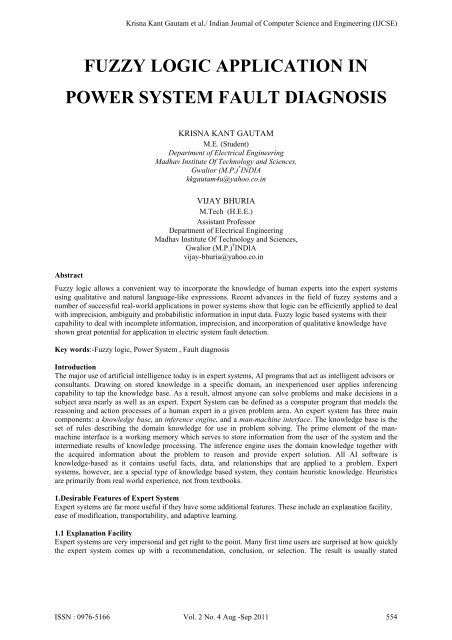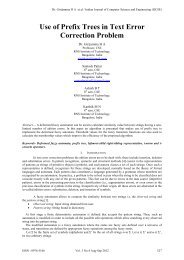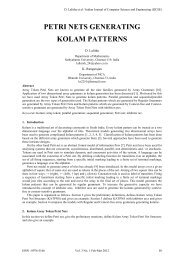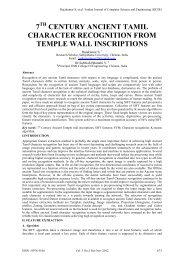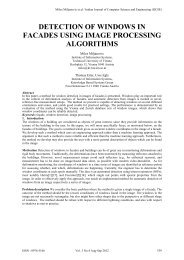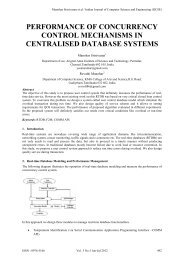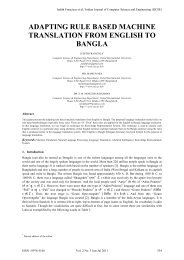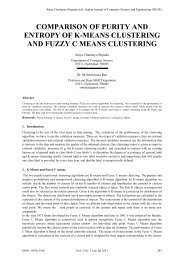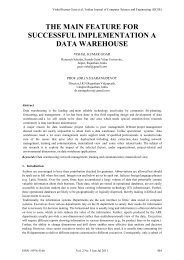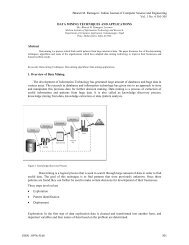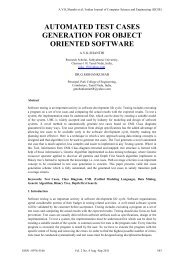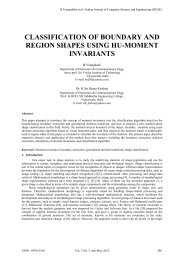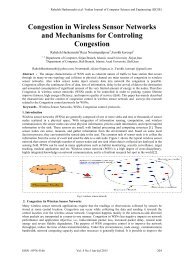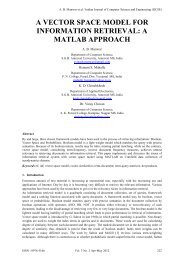fuzzy logic application in power system fault diagnosis
fuzzy logic application in power system fault diagnosis
fuzzy logic application in power system fault diagnosis
You also want an ePaper? Increase the reach of your titles
YUMPU automatically turns print PDFs into web optimized ePapers that Google loves.
Krisna Kant Gautam et al./ Indian Journal of Computer Science and Eng<strong>in</strong>eer<strong>in</strong>g (IJCSE)FUZZY LOGIC APPLICATION INPOWER SYSTEM FAULT DIAGNOSISKRISNA KANT GAUTAMM.E. (Student)Department of Electrical Eng<strong>in</strong>eer<strong>in</strong>gMadhav Institute Of Technology and Sciences,Gwalior (M.P.) * INDIAkkgautam4u@yahoo.co.<strong>in</strong>VIJAY BHURIAM.Tech (H.E.E.)Assistant ProfessorDepartment of Electrical Eng<strong>in</strong>eer<strong>in</strong>gMadhav Institute Of Technology and Sciences,Gwalior (M.P.) † INDIAvijay-bhuria@yahoo.co.<strong>in</strong>AbstractFuzzy <strong>logic</strong> allows a convenient way to <strong>in</strong>corporate the knowledge of human experts <strong>in</strong>to the expert <strong>system</strong>sus<strong>in</strong>g qualitative and natural language-like expressions. Recent advances <strong>in</strong> the field of <strong>fuzzy</strong> <strong>system</strong>s and anumber of successful real-world <strong>application</strong>s <strong>in</strong> <strong>power</strong> <strong>system</strong>s show that <strong>logic</strong> can be efficiently applied to dealwith imprecision, ambiguity and probabilistic <strong>in</strong>formation <strong>in</strong> <strong>in</strong>put data. Fuzzy <strong>logic</strong> based <strong>system</strong>s with theircapability to deal with <strong>in</strong>complete <strong>in</strong>formation, imprecision, and <strong>in</strong>corporation of qualitative knowledge haveshown great potential for <strong>application</strong> <strong>in</strong> electric <strong>system</strong> <strong>fault</strong> detection.Key words:-Fuzzy <strong>logic</strong>, Power System , Fault <strong>diagnosis</strong>IntroductionThe major use of artificial <strong>in</strong>telligence today is <strong>in</strong> expert <strong>system</strong>s, AI programs that act as <strong>in</strong>telligent advisors orconsultants. Draw<strong>in</strong>g on stored knowledge <strong>in</strong> a specific doma<strong>in</strong>, an <strong>in</strong>experienced user applies <strong>in</strong>ferenc<strong>in</strong>gcapability to tap the knowledge base. As a result, almost anyone can solve problems and make decisions <strong>in</strong> asubject area nearly as well as an expert. Expert System can be def<strong>in</strong>ed as a computer program that models thereason<strong>in</strong>g and action processes of a human expert <strong>in</strong> a given problem area. An expert <strong>system</strong> has three ma<strong>in</strong>components: a knowledge base, an <strong>in</strong>ference eng<strong>in</strong>e, and a man-mach<strong>in</strong>e <strong>in</strong>terface. The knowledge base is theset of rules describ<strong>in</strong>g the doma<strong>in</strong> knowledge for use <strong>in</strong> problem solv<strong>in</strong>g. The prime element of the manmach<strong>in</strong>e<strong>in</strong>terface is a work<strong>in</strong>g memory which serves to store <strong>in</strong>formation from the user of the <strong>system</strong> and the<strong>in</strong>termediate results of knowledge process<strong>in</strong>g. The <strong>in</strong>ference eng<strong>in</strong>e uses the doma<strong>in</strong> knowledge together withthe acquired <strong>in</strong>formation about the problem to reason and provide expert solution. All AI software isknowledge-based as it conta<strong>in</strong>s useful facts, data, and relationships that are applied to a problem. Expert<strong>system</strong>s, however, are a special type of knowledge based <strong>system</strong>, they conta<strong>in</strong> heuristic knowledge. Heuristicsare primarily from real world experience, not from textbooks.1.Desirable Features of Expert SystemExpert <strong>system</strong>s are far more useful if they have some additional features. These <strong>in</strong>clude an explanation facility,ease of modification, transportability, and adaptive learn<strong>in</strong>g.1.1 Explanation FacilityExpert <strong>system</strong>s are very impersonal and get right to the po<strong>in</strong>t. Many first time users are surprised at how quicklythe expert <strong>system</strong> comes up with a recommendation, conclusion, or selection. The result is usually statedISSN : 0976-5166 Vol. 2 No. 4 Aug -Sep 2011 554
Krisna Kant Gautam et al./ Indian Journal of Computer Science and Eng<strong>in</strong>eer<strong>in</strong>g (IJCSE)concisely, and sometimes very curtly, us<strong>in</strong>g rule clauses. A natural language <strong>in</strong>terface will help improve thissituation, but that's not the ma<strong>in</strong> problem. A more important issue is that often users have difficulty <strong>in</strong> "buy<strong>in</strong>g"the output decision. They question it or perhaps don't believe it. Users frequently want to know how the expert<strong>system</strong> arrived at that answer. Most of the better expert <strong>system</strong>s have a means for expla<strong>in</strong><strong>in</strong>g their conclusion.Typically, this takes the form of show<strong>in</strong>g the rules <strong>in</strong>volved <strong>in</strong> the decision and the sequence <strong>in</strong> which they werefired. All of the <strong>in</strong>formation is reta<strong>in</strong>ed <strong>in</strong> the data base for that purpose. When users want to know the expert<strong>system</strong>'s l<strong>in</strong>e of reason<strong>in</strong>g, they can read the rules and follow the <strong>logic</strong> themselves. Some rule formats permit the<strong>in</strong>clusion of an explanation statement that justifies or elaborates on the need for or importance of the rule. Theexplanation facility is important because it helps the user feel comfortable with the outcome. Sometimes theoutcome is a surprise or somewhat different than expected. It is difficult for an <strong>in</strong>dividual to follow the advice ofthe expert <strong>in</strong> these cases. However, once the expert <strong>system</strong> expla<strong>in</strong>s itself, the user better understands thedecision and feels more at ease <strong>in</strong> mak<strong>in</strong>g a decision based upon it.1.2 Ease of ModificationAs <strong>in</strong>dicated earlier, the <strong>in</strong>tegrity of the knowledge base depends upon how accurate and up to date it is. Indoma<strong>in</strong>s where rapid changes take place, it is important that some means be provided for quickly and easily<strong>in</strong>corporat<strong>in</strong>g this knowledge. When the expert <strong>system</strong> was developed us<strong>in</strong>g one of the newer developmenttools, it is usually a simple matter to modify the knowledge base by writ<strong>in</strong>g new rules, modify<strong>in</strong>g exist<strong>in</strong>g rules,or remov<strong>in</strong>g rules. The better <strong>system</strong>s have special software sub<strong>system</strong>s which allow these changes to be madewithout difficulty. If the <strong>system</strong> has been programmed <strong>in</strong> LISP or Prolog, changes are much more difficult tomake. In exam<strong>in</strong><strong>in</strong>g or evaluat<strong>in</strong>g an expert <strong>system</strong>, this feature should be considered seriously <strong>in</strong> context of themodification.1.3 TransportabilityThe wider the availability of an expert <strong>system</strong> the more useful the <strong>system</strong> will be. An expert <strong>system</strong> is usuallydesigned to operate on one particular type of computer, and this is usually dictated by the software developmenttools used to create the expert <strong>system</strong>. If the expert <strong>system</strong> will operate on only one type of computer, itspotential exposure is reduced. The more different types of computers for which the expert <strong>system</strong> is available,the more widely the expertise can be used. If possible, when the expert <strong>system</strong> is to be developed, it should bedone <strong>in</strong> such a way that it is readily transportable to different types of mach<strong>in</strong>es. This may mean choos<strong>in</strong>g aprogramm<strong>in</strong>g language or software development tool that is available on more than one target mach<strong>in</strong>e.1.3 Adaptive Learn<strong>in</strong>g AbilityThis is an advanced feature of some expert <strong>system</strong>s that allows them to learn their own use or experience. As theexpert <strong>system</strong> is be<strong>in</strong>g operated, the eng<strong>in</strong>e will draw conclusions that can, <strong>in</strong> fact, produce new knowledge.New functions stored temporarily <strong>in</strong> the data base, but <strong>in</strong> some <strong>system</strong>s they can lead to the development of anew rule which can be stored <strong>in</strong> the knowledge base and used aga<strong>in</strong> <strong>in</strong> the problem. The more the <strong>system</strong> isused, the more it learns about the doma<strong>in</strong> and more valuable it becomes. The term learn<strong>in</strong>g as applied to expert<strong>system</strong>s refers to the process of the expert <strong>system</strong> new th<strong>in</strong>gs by add<strong>in</strong>g additional rules or modify<strong>in</strong>g exist<strong>in</strong>grules. On the other hand, if the <strong>system</strong> <strong>in</strong>corporates the ability to learn it becomes a much more <strong>power</strong>ful andeffective problem solver. Today few expert <strong>system</strong>s have this capability, but it is a feature that is sure to befurther developed <strong>in</strong>to future <strong>system</strong>s.2. Expert System ApplicationsExpert <strong>system</strong>s are ideal when it is necessary for an <strong>in</strong>dividual to select the best alternative from a long list ofchoices. Based on the criteria supplied to it, the expert <strong>system</strong> can choose the best option. In <strong>power</strong> <strong>system</strong>s,many promis<strong>in</strong>g <strong>application</strong>s have been reported <strong>in</strong> the broad field of <strong>system</strong> control, alarm process<strong>in</strong>g and <strong>fault</strong><strong>diagnosis</strong>, <strong>system</strong> monitor<strong>in</strong>g, decision support, <strong>system</strong> analysis and plann<strong>in</strong>g. An excellent review of thepopular <strong>application</strong> areas can be found <strong>in</strong> [1].3.Reason<strong>in</strong>g with Uncerta<strong>in</strong>ty <strong>in</strong> Rule Based Expert SystemsOne of the important feature <strong>in</strong> expert <strong>system</strong>s is their ability to deal with <strong>in</strong>correct or uncerta<strong>in</strong> <strong>in</strong>formation.Traditional algorithmic software simply cannot deal with <strong>in</strong>complete <strong>in</strong>formation. If the data is <strong>in</strong>correct, theanswer will be <strong>in</strong>correct. This is where artificial <strong>in</strong>telligence programs, particularly expert <strong>system</strong>s, areparticularly useful. When the <strong>in</strong>puts are ambiguous or completely miss<strong>in</strong>g, the program may still f<strong>in</strong>d a solutionto problem. The <strong>system</strong> may qualify that solution, but at least it is an answer that can <strong>in</strong> many cases be put topractical use. Thus, <strong>in</strong> the design of expert <strong>system</strong>s, there has been a focus on methods of obta<strong>in</strong><strong>in</strong>g approximatesolutions to a problem when there is no clear conclusion from the given data. Logically, as expert <strong>system</strong>problems become more complex, the difficulty of reach<strong>in</strong>g a conclusion with complete certa<strong>in</strong>ty <strong>in</strong>creases, so <strong>in</strong>some cases, there must be a method of hand<strong>in</strong>g uncerta<strong>in</strong>ty. In [2,3], researchers have reported that a classicalISSN : 0976-5166 Vol. 2 No. 4 Aug -Sep 2011 555
Krisna Kant Gautam et al./ Indian Journal of Computer Science and Eng<strong>in</strong>eer<strong>in</strong>g (IJCSE)expert <strong>system</strong> gave <strong>in</strong>correct results due to the sharpness of the boundaries created by the if-then rules of the<strong>system</strong>; however, once a method for deal<strong>in</strong>g with uncerta<strong>in</strong>ty (<strong>in</strong> these two cases <strong>fuzzy</strong> set theory) was used,the expert <strong>system</strong> reached the desired conclusions. The expert knowledge takes the form of heuristics,procedural rules and strategies <strong>in</strong> nature. It <strong>in</strong>herently conta<strong>in</strong>s vagueness and imprecision. Uncerta<strong>in</strong>ty <strong>in</strong> rulebased expert <strong>system</strong>s occurs <strong>in</strong> two forms. The first form is l<strong>in</strong>guistic uncerta<strong>in</strong>ty which occurs if an antecedentconta<strong>in</strong>s vague statements such as the level is high" or "the value is near 20". The other form of uncerta<strong>in</strong>ty,called evidential uncerta<strong>in</strong>ty, occurs if the relationship between an observation and a conclusion is not entirelycerta<strong>in</strong>. This type of uncerta<strong>in</strong>ty is most commonly handled us<strong>in</strong>g conditional probability which <strong>in</strong>dicates thelikelihood that a particular observation leads to a specific conclusion. The study of mak<strong>in</strong>g decisions undereither of these types of uncerta<strong>in</strong>ty will be referred to as plausible or approximate reason<strong>in</strong>g <strong>in</strong> this work.Several methods of deal<strong>in</strong>g with uncerta<strong>in</strong>ty <strong>in</strong> expert <strong>system</strong>s have been proposed, <strong>in</strong>clud<strong>in</strong>gSubjective probabilityCerta<strong>in</strong>ty factorsFuzzy measuresFuzzy set theoryThe first three methods are generally used to handle evidential uncerta<strong>in</strong>ty, while the last method, <strong>fuzzy</strong> settheory is used to <strong>in</strong>corporate l<strong>in</strong>guistic uncerta<strong>in</strong>ty. [4]. As expert assessments of the <strong>in</strong>dicators of the problemmay be imprecise, <strong>fuzzy</strong> sets may be used for determ<strong>in</strong><strong>in</strong>g the degree to which a rule from the expert <strong>system</strong>applies to the data that is analyzed.4.Fuzzy LogicAnother method of deal<strong>in</strong>g with imprecise or uncerta<strong>in</strong> knowledge is to use <strong>fuzzy</strong> <strong>logic</strong>. Fuzzy <strong>logic</strong> is a <strong>system</strong>conceived by Zadeh for deal<strong>in</strong>g <strong>in</strong> <strong>in</strong>exact or unreliable <strong>in</strong>formation. In this method, an attempt is made toassign numerical ranges with a possibility value between zero and one to concepts and elements with values thatare hard to p<strong>in</strong> down. It allows you to work with ambiguous or <strong>fuzzy</strong> quantities such as large or small, or datathat is subject to <strong>in</strong>terpretation.FIG 1. Fuzzy Sets for representation of uncerta<strong>in</strong>ity5. Fault DiagnosisIn the past few years, great emphasis has been put <strong>in</strong> apply<strong>in</strong>g the expert <strong>system</strong>s for transmission <strong>system</strong> <strong>fault</strong><strong>diagnosis</strong>. However, very few papers deal with the unavoidable uncerta<strong>in</strong>ties that occur dur<strong>in</strong>g operation<strong>in</strong>volv<strong>in</strong>g the <strong>fault</strong> location and other available <strong>in</strong>formation. This paper shows a method us<strong>in</strong>g <strong>fuzzy</strong> sets to copewith such uncerta<strong>in</strong>ties.5.1 Problem StatementTo reduce the outage time and enhance service reliability, it is essential for dispatchers to locate <strong>fault</strong> sections <strong>in</strong>a <strong>power</strong> <strong>system</strong> as soon as possible. Currently, heuristic rules from dispatchers’ past experiences are extensivelyused <strong>in</strong> <strong>fault</strong> <strong>diagnosis</strong>. The important role of such experience has motivated extensive recent work [5-11] on the<strong>application</strong> of expert <strong>system</strong> <strong>in</strong> this field. A few papers have described and dealt with uncerta<strong>in</strong>ties <strong>in</strong>volv<strong>in</strong>g the<strong>fault</strong> location and other <strong>in</strong>formation available [12-15]. These uncerta<strong>in</strong>ties occur due to failures of protectiverelays and breakers, errors of local acquisition and transmission, and <strong>in</strong>accurate occurrence time, etc. Aneffective approach is thus necessary to deal with uncerta<strong>in</strong>ties <strong>in</strong> these expert <strong>system</strong>s. Fault <strong>diagnosis</strong> <strong>in</strong> electric<strong>power</strong> <strong>system</strong> is a facet operation. Every signal and step conta<strong>in</strong> some uncerta<strong>in</strong>ties, which can be modeled bymembership functions. Fuzzy set theory is used to determ<strong>in</strong>e the most likely <strong>fault</strong> sections <strong>in</strong> the approachpresented here. Membership functions of the possible <strong>fault</strong> sections are the most important factors <strong>in</strong> the<strong>in</strong>ference procedures and decision mak<strong>in</strong>g. In this example, the membership function of a hypothesis is used todescribe the extent to which the available <strong>in</strong>formation and the <strong>system</strong> knowledge match the hypothesis. They aremanipulated dur<strong>in</strong>g <strong>in</strong>ference based on rules concern<strong>in</strong>g <strong>fault</strong> sections.ISSN : 0976-5166 Vol. 2 No. 4 Aug -Sep 2011 556
Krisna Kant Gautam et al./ Indian Journal of Computer Science and Eng<strong>in</strong>eer<strong>in</strong>g (IJCSE)5.2 Structure of the Fault Diagnosis SystemThe <strong>fuzzy</strong> expert <strong>system</strong> structure is shown <strong>in</strong> Fig. 2. Its database conta<strong>in</strong>s the <strong>power</strong> <strong>system</strong> topology, and thestatus of all breakers and protective relays after the <strong>fault</strong>.ONLINE DATA FROM POWER STATIONDispatcher<strong>in</strong>ter faceDatabaseFault NetworkIdentificationKnowledge baseHypothesis andcalculationsInference Eng<strong>in</strong>eFault DetectionFIG 2 Fuzzy expert <strong>system</strong> structureThe knowledge base of the <strong>fuzzy</strong> expert <strong>system</strong> conta<strong>in</strong>s all the data of the protection <strong>system</strong>. The <strong>in</strong>formation isbased on known statistics of protection performance used <strong>in</strong> the <strong>system</strong>. If these data are not available when a<strong>fault</strong> occurs, the <strong>fuzzy</strong> expert <strong>system</strong> asks the dispatcher to provide them and then saves them <strong>in</strong> the database forfuture use. Models for estimation of possible <strong>fault</strong>s, and heuristic rules about the relay characteristics for actual<strong>fault</strong> determ<strong>in</strong>ation are also <strong>in</strong>cluded here.5.3 Island IdentificationWhen a <strong>fault</strong> occurs <strong>in</strong> a <strong>power</strong> <strong>system</strong>, the relays correspond<strong>in</strong>g to the <strong>fault</strong> sections should trip the circuitbreakers to isolate the <strong>fault</strong> sections from be<strong>in</strong>g extended. Thus the <strong>power</strong> <strong>system</strong> is separated <strong>in</strong>to several partsnamed sub networks after the operation of protective relays and circuit breakers. Generally, only a fewsubsections are formed from the <strong>fault</strong>s. S<strong>in</strong>ce the <strong>fault</strong> sections are conf<strong>in</strong>ed to these sub networks, Themagnitude of the problem can be reduced greatly. An expert <strong>system</strong> is developed to identify the island by us<strong>in</strong>gthe real-time <strong>in</strong>formation of circuit breakers and adopt<strong>in</strong>g the real-time network topology determ<strong>in</strong>ation method[17]. The framework of this efficient method is described asfollows:Initializ<strong>in</strong>g the network: The expert <strong>system</strong> identifies the <strong>power</strong> <strong>system</strong> pre-<strong>fault</strong> status as the normaloperation state by us<strong>in</strong>g the real-time network topology determ<strong>in</strong>ation method [17]. When a <strong>fault</strong>occurs, the <strong>power</strong> <strong>system</strong> status would be changed by the operation of relays and circuit breakers.Healthy sub network identification: The next step is to identify the network topology of the healthy partof the post-<strong>fault</strong> <strong>power</strong> <strong>system</strong> by us<strong>in</strong>g the real-time network topology determ<strong>in</strong>ation method [18]. Thehealthy sub network is called set Shealthy.Island identification: By compar<strong>in</strong>g the <strong>in</strong>itial network topology with the healthy subnetwork topology,the differences between them are identified as the island. This sub network is called Sisland. Thismethod was proven <strong>in</strong> a case study that consists of 43 substations, 523 sections, 412 circuit breakers,107 busbar, 23 three-w<strong>in</strong>d<strong>in</strong>g transformers and 77 transmission. The simulat<strong>in</strong>g results are quitesatisfactory [17]. The required process<strong>in</strong>g time to identify the island is less than 2 seconds <strong>in</strong> a 486micro-computer <strong>in</strong> all the simulated cases.5.4 Fault Section IdentificationWhen a <strong>fault</strong> occurs, the change <strong>in</strong> breaker status activates the <strong>fuzzy</strong> expert <strong>system</strong>. It then classifies thebreakers <strong>in</strong>to two sets: no-trip status set and tripped status set. a <strong>fault</strong> hypothesis Fi is formed as follows:ISSN : 0976-5166 Vol. 2 No. 4 Aug -Sep 2011 557
Krisna Kant Gautam et al./ Indian Journal of Computer Science and Eng<strong>in</strong>eer<strong>in</strong>g (IJCSE)--------- (1)-----------(2)---------(3)where Ci is one of the possible <strong>fault</strong> sections be<strong>in</strong>g considered; P<strong>fault</strong> is the <strong>fuzzy</strong> set which conta<strong>in</strong> all thepossible <strong>fault</strong> sections and their membership functions; Fi(CB) is the <strong>fuzzy</strong> subset by consider<strong>in</strong>g only thetripped circuit breakers; Fi(RL) is the <strong>fuzzy</strong> subset by consider<strong>in</strong>g only the operated relays.5.5. ConclusionGenerally, a conventional rule-based expert <strong>system</strong> for bulk <strong>power</strong> <strong>system</strong> needs several hundreds of rules. It istime consum<strong>in</strong>g <strong>in</strong> <strong>in</strong>ference procedures to search for suitable rules dur<strong>in</strong>g <strong>in</strong>ferenc<strong>in</strong>g. On the other hand, <strong>fuzzy</strong>set based expert <strong>system</strong>s tend to be much faster compared to traditional rule-based expert <strong>system</strong>s for most ofthe rules are replaced by the calculation of the membership functions of the applicable rules . Only a few rulesor functions are used <strong>in</strong> the <strong>in</strong>ference eng<strong>in</strong>e. The <strong>fuzzy</strong> set approach for uncerta<strong>in</strong>ty process<strong>in</strong>g <strong>in</strong> expert<strong>system</strong>s offers many advantages to compared other approaches to deal with uncerta<strong>in</strong>ty.Small memory space and computer time: The knowledge base is very small because there are only a few rulesneeded dur<strong>in</strong>g <strong>in</strong>ference. The computationtime is therefore also small.o Small number of rules: With properly designed l<strong>in</strong>guistic variables and level of granularity,only a few <strong>fuzzy</strong> rules are needed for each situation.o Flexibility of the <strong>system</strong>: Membership functions represent<strong>in</strong>g the parameters can be changeddynamically accord<strong>in</strong>g to the situation. It is also possible to develop a self-learn<strong>in</strong>g modulethat modifies the grades of membership automatically accord<strong>in</strong>g to chang<strong>in</strong>g situations.5.6 References[1] T. S. Dillon and M. A. Laughton, Expert System Applications <strong>in</strong> Power Systems, Prentice Hall International Series <strong>in</strong> Power SystemsComputation.[2] N. Vadiee and M. Jamshidi, “The Promis<strong>in</strong>g Future of Fuzzy Logic,” IEEE Expert, August 1994, pg. 37.[3] R. Levi, M. Rivers and K. Hickey, “An Intelligent Instrument for High Voltage Equipment Insulation Evaluation,” Proceed<strong>in</strong>gs of the1994 International Conference on Intelligent System Application to Power Systems, France, Sept.[4] 1994, pp. 471-476.[5] S.C. Shapiro, ed., Encyclopedia of Artificial Intelligence, Wiley, New York, 1992.[6] Yuan-Yih Hsu, F. C. Lu, Y. Chien, et al., “An expert <strong>system</strong> for locat<strong>in</strong>g distribution <strong>system</strong> <strong>fault</strong>s,” IEEE Trans. on[7] PWRD, Vol. 5, No. 2, pp366-371.[8] M. Kezunovic, C. W. Fromen, et al., “An expert <strong>system</strong> for transmission substation event analysis,” IEEE Trans. on Power Delivery,Vol.8, No. 4, Oct. 1993, pp1942-1949.[9] J.R. McDonald, G.M.Burt D.J. Young, “Alarm process<strong>in</strong>g and <strong>fault</strong> <strong>diagnosis</strong> us<strong>in</strong>g knowledge based <strong>system</strong>s for[10] transmission and distribution network control,” IEEE Trans. on Power Systems, Vol.7, No.3, Aug. 1992, pp1292-1298.[11] Takafumi Kimura, S<strong>in</strong>ya Nishimatsu, et al., “Development of an expert <strong>system</strong> for estimat<strong>in</strong>g <strong>fault</strong> section <strong>in</strong> control center based onprotective <strong>system</strong> simulation,” IEEE Trans. On Power Delivery, Vol.7, No.1, Jan., 1992, pp167-172.[12] C.A. Protopapas, A.V. Machias, et al., “An expert <strong>system</strong> for substation <strong>fault</strong> <strong>diagnosis</strong> and alarm process<strong>in</strong>g,” IEEE Trans. on PowerDelivery, Vol.6, No.2, April 1991, pp648-655.[13] Benoit Valiquette, Germano Lambert Torres, “An expert <strong>system</strong> based <strong>diagnosis</strong> and advisor tool for teach<strong>in</strong>g <strong>power</strong>[14] <strong>system</strong> operation emergency control strategies,” IEEE Trans. on Power Systems, Vol.6, No.3, Aug. 1991, pp1315-1322.[15] Chihiro Fukui, Junzo Kawakami, “An expert <strong>system</strong> for <strong>fault</strong> section estimation us<strong>in</strong>g <strong>in</strong>formation from protective relays and circuitbreakers,” IEEE Trans. on Power Delivery, Vol. PWRD-1, No.4, Oct. 1986.[16] C.S Chang, J.M. Chen et al., “Power <strong>system</strong> <strong>fault</strong> <strong>diagnosis</strong> us<strong>in</strong>g <strong>fuzzy</strong> sets for uncerta<strong>in</strong>ties process<strong>in</strong>g,” accepted for[17] publication <strong>in</strong> ISAP’96, Orlando, USA.[18] C.S. Chang, J.M. Chen, A. C. Liew, “An expert <strong>system</strong> approach for <strong>fault</strong> <strong>diagnosis</strong> consider<strong>in</strong>g uncerta<strong>in</strong>ties,” Proceed<strong>in</strong>gs ofInternational Conference on Intelligent Manufacture<strong>in</strong>g’95 (ICIM’95), Wuhan, Ch<strong>in</strong>a, June, 1995.[19] Cho H.J., Park J. K., Lee H. J., “A <strong>fuzzy</strong> expert <strong>system</strong> for <strong>fault</strong> <strong>diagnosis</strong> of <strong>power</strong> <strong>system</strong>s,” Proceed<strong>in</strong>gs of ISAP’94, Montpellier,France, Sept., 1994, pp217-222.[20] P. Jarventausta, P. Verho, J. Partanen, “Us<strong>in</strong>g <strong>fuzzy</strong> sets to model the uncerta<strong>in</strong>ty <strong>in</strong> the <strong>fault</strong> location process of[21] distribution networks,” IEEE Trans. on Power Delivery, Vol.9, No. 2, April 1994, pp954-960.[22] Zhu Yongli, Y.H. Yang, B. W. Hogg, W.Q. Zhang, S. Gao, “An expert <strong>system</strong> for <strong>power</strong> <strong>system</strong>s <strong>fault</strong> analysis,” IEEE[23] Trans. on Power Systems, Vol. 9, No. 1, Feb., 1994, pp503- 509.[24] Fushan Wen and Zhenxiang Han, “Optimal <strong>fault</strong> section estimation <strong>in</strong> <strong>power</strong> <strong>system</strong>s us<strong>in</strong>g a genetic algorithm,”[25] accepted for Journal of Electric Power Systems Research.ISSN : 0976-5166 Vol. 2 No. 4 Aug -Sep 2011 558


